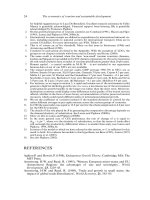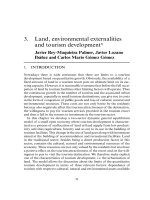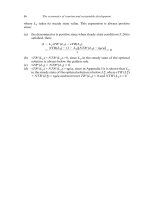THE ECONOMICS OF MONEY,BANKING, AND FINANCIAL MARKETS 155
Bạn đang xem bản rút gọn của tài liệu. Xem và tải ngay bản đầy đủ của tài liệu tại đây (36.53 KB, 1 trang )
CHAPTER 6
The Risk and Term Structure of Interest Rates
123
We can make this argument more general. For an investment of $1, consider
the choice of holding, for two periods, a two-period bond or two one-period
bonds. Using the definitions
it
today s (time t) interest rate on a one-period bond
i te 1
interest rate on a one-period bond expected for next period (time t
i2t
today s (time t) interest rate on the two-period bond
1)
the expected return over the two periods from investing $1 in the two-period bond
and holding it for the two periods can be calculated as
(1
i2t )(1
i2t )
1
1
(i2t )2
2i2t
1
2i2t
(i2t )2
After the second period, the $1 investment is worth (1
i2t )(1
i2t ). Subtracting
the $1 initial investment from this amount and dividing by the initial $1 investment
gives the rate of return calculated in the above equation. Because (i2t )2 is extremely
small if i2t 10% 0.10, then (i2t )2 0.01 we can simplify the expected return
for holding the two-period bond for the two periods to
2i2t
With the other strategy, in which one-period bonds are bought, the expected
return on the $1 investment over the two periods is
(1
it )(1
i te+ 1) - 1
1 + it + i te+ 1
it (i te+ 1) - 1 = it + i te+ 1 + it (i te+ 1)
This calculation is derived by recognizing that after the first period, the $1 investment
becomes 1 it , and this is reinvested in the one-period bond for the next period,
e
yielding an amount (1 it )(1 i t+1
). Then, subtracting the $1 initial investment
from this amount and dividing by the initial investment of $1 gives the expected
return for the strategy of holding one-period bonds for the two periods. Because
e
e
it (i et+1) is also extremely small if i t i t+1
0.10, then it (i t+1
)
0.01 we can
simplify this to
it +i et+1
Both bonds will be held only if these expected returns are equal, that is, when
2i2t
it
i et+1
Solving for i2t in terms of the one-period rates, we have
i2t
it + i et
2
1
(1)
which tells us that the two-period rate must equal the average of the two oneperiod rates. Graphically, this can be shown as:
Today
0
Year
1
it
i 2t
it
ite
2
ite 1
1
Year
2









